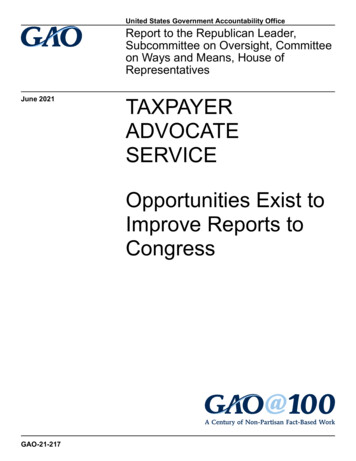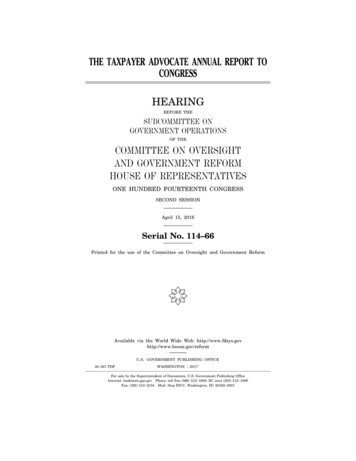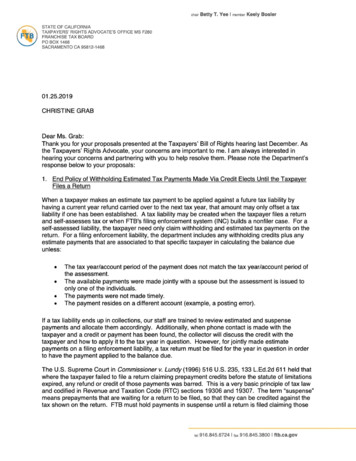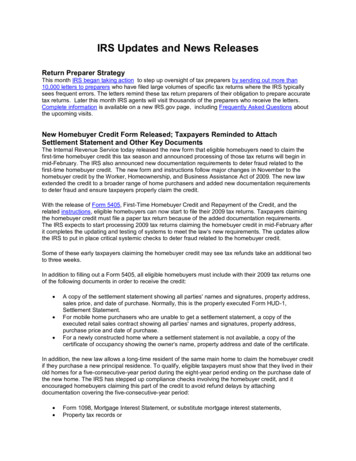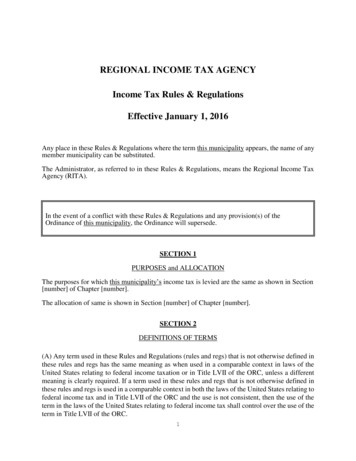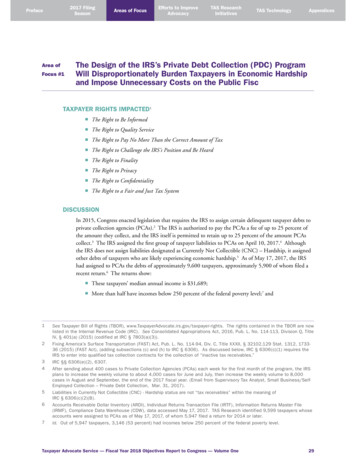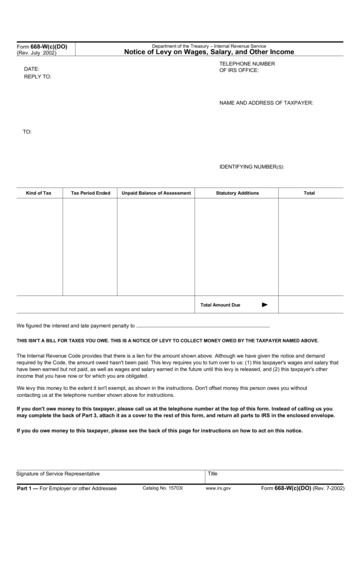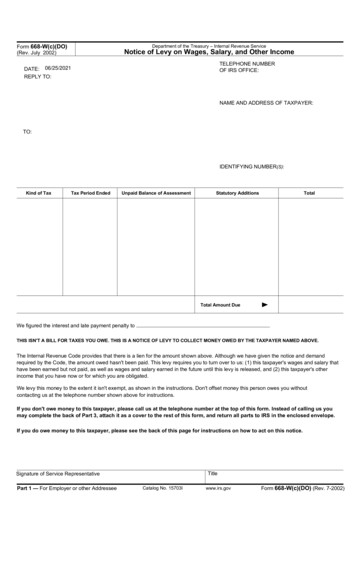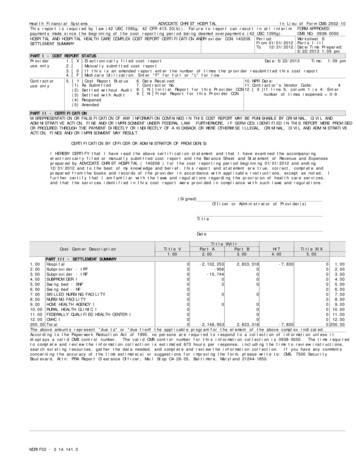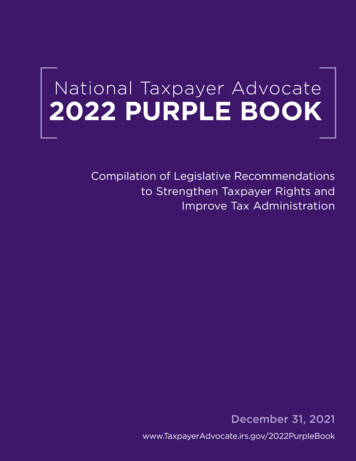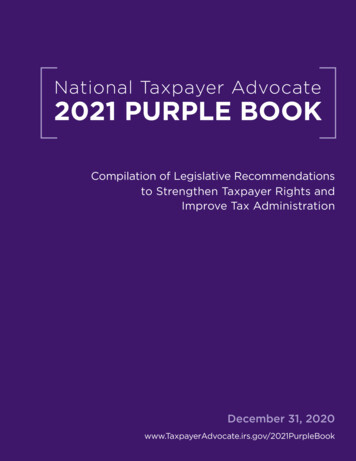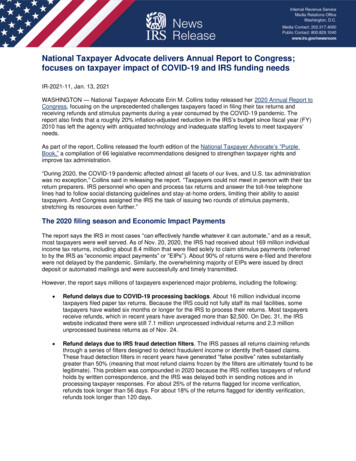
Transcription
National Taxpayer Advocate delivers Annual Report to Congress;focuses on taxpayer impact of COVID-19 and IRS funding needsIR-2021-11, Jan. 13, 2021WASHINGTON — National Taxpayer Advocate Erin M. Collins today released her 2020 Annual Report toCongress, focusing on the unprecedented challenges taxpayers faced in filing their tax returns andreceiving refunds and stimulus payments during a year consumed by the COVID-19 pandemic. Thereport also finds that a roughly 20% inflation-adjusted reduction in the IRS’s budget since fiscal year (FY)2010 has left the agency with antiquated technology and inadequate staffing levels to meet taxpayers’needs.As part of the report, Collins released the fourth edition of the National Taxpayer Advocate’s “PurpleBook,” a compilation of 66 legislative recommendations designed to strengthen taxpayer rights andimprove tax administration.“During 2020, the COVID-19 pandemic affected almost all facets of our lives, and U.S. tax administrationwas no exception,” Collins said in releasing the report. “Taxpayers could not meet in person with their taxreturn preparers. IRS personnel who open and process tax returns and answer the toll-free telephonelines had to follow social distancing guidelines and stay-at-home orders, limiting their ability to assisttaxpayers. And Congress assigned the IRS the task of issuing two rounds of stimulus payments,stretching its resources even further.”The 2020 filing season and Economic Impact PaymentsThe report says the IRS in most cases “can effectively handle whatever it can automate,” and as a result,most taxpayers were well served. As of Nov. 20, 2020, the IRS had received about 169 million individualincome tax returns, including about 8.4 million that were filed solely to claim stimulus payments (referredto by the IRS as “economic impact payments” or “EIPs”). About 90% of returns were e-filed and thereforewere not delayed by the pandemic. Similarly, the overwhelming majority of EIPs were issued by directdeposit or automated mailings and were successfully and timely transmitted.However, the report says millions of taxpayers experienced major problems, including the following: Refund delays due to COVID-19 processing backlogs. About 16 million individual incometaxpayers filed paper tax returns. Because the IRS could not fully staff its mail facilities, sometaxpayers have waited six months or longer for the IRS to process their returns. Most taxpayersreceive refunds, which in recent years have averaged more than 2,500. On Dec. 31, the IRSwebsite indicated there were still 7.1 million unprocessed individual returns and 2.3 millionunprocessed business returns as of Nov. 24. Refund delays due to IRS fraud detection filters. The IRS passes all returns claiming refundsthrough a series of filters designed to detect fraudulent income or identity theft-based claims.These fraud detection filters in recent years have generated “false positive” rates substantiallygreater than 50% (meaning that most refund claims frozen by the filters are ultimately found to belegitimate). This problem was compounded in 2020 because the IRS notifies taxpayers of refundholds by written correspondence, and the IRS was delayed both in sending notices and inprocessing taxpayer responses. For about 25% of the returns flagged for income verification,refunds took longer than 56 days. For about 18% of the returns flagged for identity verification,refunds took longer than 120 days.page 1
EIP underpayments. In accordance with the Coronavirus Aid, Relief, and Economic Security(CARES) Act, the IRS issued more than 160 million EIPs. However, millions of eligible individualsdid not receive some or all of the EIPs for which they were eligible despite a statutory directivethat the IRS issue the payments “as rapidly as possible.” Initially, the IRS took the position that itgenerally would not correct EIP mistakes in 2020. As the year progressed, the IRS agreed to fixsome categories of EIP problems, mostly those it could fix via automation. Still, the IRS wasunable to resolve many cases in 2020, requiring eligible individuals to wait until they file their2020 tax returns in 2021 to receive their payments. Late notices. During 2020, taxpayers were sent more than 20 million notices bearing dates thathad passed and, in many cases, response or payment deadlines that also had passed. Thishappened because on two occasions during the year, IRS computers automatically generatednotices that the IRS did not have the capacity to mail at the time. Rather than reprint the noticeswith new dates, the IRS decided to include “inserts” with about 1.8 million notices explaining thattaxpayers would have additional time to respond. But the IRS failed to include these inserts withother notices that should have contained them and had to issue supplemental letters informingtaxpayers of additional extensions. For affected taxpayers, this caused confusion and, in somecases, undue stress and concern. Among the late notices were collection notices and math errornotices, where the failure to timely respond could mean loss of rights. Lack of information about backlogs, notices, and other problems. The report says the IRSshould have done a better job of keeping the public informed about COVID-19-related delays bycreating a regularly updated “COVID-19 Dashboard” and issuing weekly news releases to ensurethe information was widely disseminated. While the IRS did post limited information on IRS.govduring the latter part of the year, it was not well-promoted and it was not regularly updated. Asmentioned above, for example, the IRS website on Dec. 31 contained an update posted on Dec.1 that stated the numbers of unprocessed individual and business returns as of Nov. 24 were 7.1million and 2.3 million, respectively, and that some unprocessed returns dated back to April 15.The report says the public will benefit if the IRS begins to update its backlog information weekly,and the IRS and TAS consequently will receive fewer calls from taxpayers reaching out solely toobtain that information.Inadequate funding is the source of many (not all) taxpayer problemsBy statute, the National Taxpayer Advocate is required to identify the ten most serious problemsencountered by taxpayers in their dealings with the IRS. In her preface to the report, Collins wrote: “If thisyear’s Most Serious Problems are read in combination, one overriding theme emerges: To improvetaxpayer service, the IRS needs more resources to hire employees and more resources to modernize itsinformation technology (IT) systems.”Among the Most Serious Problems are the following: Insufficient employee hiring and retention. Since FY 2010, the IRS workforce has shrunk byapproximately 20%, about even with the inflation-adjusted reduction in the IRS budget.Inadequate funding combined with weaknesses in hiring and retention strategies have created aninsufficient and disproportionately aging workforce, with an estimated 26% of IRS employeeseligible to retire during FY 2021. The report says insufficient experienced staffing in the IRS’sHuman Capital Office and hiring restrictions outside its control have left the IRS ill-equipped tohandle the agency’s hiring needs. TAS recommends the IRS hire additional human resourcespecialists to meet hiring needs, restructure internal hiring processes to reduce cycle times, andrenegotiate the hiring process with the National Treasury Employees Union to allow for up to50% of all hiring announcements to be filled externally.page 2
Inadequate telephone and in-person taxpayer service. In FY 2020, the IRS received morethan 100 million calls on its toll-free telephone lines. IRS employees answered only about 24million. Taxpayers who got through waited an average of 18 minutes on hold. In recent years, theIRS has been serving fewer taxpayers in its Taxpayer Assistance Centers (TACs), and theCOVID-19 pandemic exacerbated that trend. The number of taxpayers the IRS has served faceto-face has declined from 4.4 million five years ago in FY 2016, to 2.3 million in FY 2019, to 1.0million in FY 2020. To improve telephone and TAC services, TAS recommends that the IRSprioritize the expansion of “customer callback” technology and give taxpayers the option ofreceiving face-to-face service through videoconferencing. Limited functionality of online taxpayer accounts. The report says online taxpayer accountsare plagued by limited functionality. For example, taxpayers generally cannot view images ofpast tax returns, most IRS notices, or proposed assessments; file documents; or update theiraddresses or the names of authorized representatives. The inability to conduct transactionsonline is frustrating for taxpayers who have been conducting comparable transactions withfinancial institutions for more than two decades and increases the number of telephone calls andpieces of correspondence the IRS receives. TAS recommends the IRS expedite the expansion ofonline taxpayer accounts. Antiquated information technology. The IRS continues to operate the two oldest major ITsystems still in use in the federal government, dating to the early 1960s. The IRS also operatesabout 60 case management systems that generally are not interoperable. The report saysobsolete systems limit the functionality of taxpayer accounts, prevent taxpayers from obtainingfull details about the status of their cases, and impede the IRS’s ability to select the best casesfor compliance actions.Other Most Serious Problems include inadequate digital communication options; limitations on the abilityof some taxpayers to e-file their tax returns; challenges in the correspondence examination process;inappropriate imposition of foreign information reporting penalties; delays in the processing of amendedtax returns; and refund delays attributable to refund fraud filters.The report says a common link among these taxpayer problems is inadequate funding to allow the IRS toadminister the tax system as well as it could. “The IRS is the accounts receivable department of thefederal government,” Collins wrote. “In FY 2020, it collected about 3.5 trillion on a budget of about 11.51 billion, producing a remarkable return on investment of more than 300:1. For this reason, it iseconomically irrational to underfund the IRS.”The report says the IRS needs more funding to hire enough customer service representatives to answertaxpayer telephone calls and significant additional funding to modernize its IT systems. The IRS hasdeveloped a roadmap known as the “Integrated Modernization Business Plan” that would replace legacysystems with modern technology systems and enable the agency to provide improved service totaxpayers and deliver long-term budget efficiencies. The IRS has estimated it will require between 2.3billion and 2.7 billion in additional funding over the next six years to implement this plan. Yet in FY 2020,the Business Systems Modernization account was funded at only 180 million. The funding level hasbeen raised to 223 million in FY 2021, but the report calls that amount “a drop in the bucket compared tothe IRS’s IT funding needs.”The report points out that the IRS recently developed comprehensive multi-year plans to improvetaxpayer services and modernize its IT systems, as required by the Taxpayer First Act. Included in theplans are initiatives TAS has been proposing for several years, “including customer callback, robustonline accounts, a focus on resolving taxpayer issues at the earliest possible time, and the use of digitaltools to improve service.” Collins wrote that the plans, if implemented, “will be a game-changer fortaxpayers,” but noted they are dependent on funding.page 3
National Taxpayer Advocate “Purple Book” of legislative recommendationsThe National Taxpayer Advocate’s 2021 Purple Book proposes 66 legislative recommendations forconsideration by Congress. Among them are the following: Authorize the IRS to establish minimum standards for tax return preparers. Most taxpayershire tax return preparers to complete their returns, and visits to preparers by GovernmentAccountability Office and Treasury Inspector General for Tax Administration auditors posing astaxpayers, as well as IRS compliance studies, have found preparers make significant errors thatboth harm taxpayers and reduce tax compliance. Nearly ten years ago, the IRS sought toimplement minimum preparer standards, including requiring otherwise non-credentialed preparersto pass a basic competency test, but a federal court concluded the IRS could not do so withoutstatutory authorization. TAS recommends Congress provide that authorization. Expand the U.S. Tax Court’s jurisdiction to hear refund cases. Under current law, taxpayerswho owe tax and wish to litigate a dispute with the IRS must go to the U.S. Tax Court, whiletaxpayers who have paid their tax and are seeking a refund must file suit in a U.S. district court orthe U.S. Court of Federal Claims. TAS recommends that all taxpayers be given the option tolitigate their tax disputes in the U.S. Tax Court. Restructure the Earned Income Tax Credit (EITC) to make it simpler for taxpayers andreduce improper payments. TAS has long advocated for dividing the EITC into two separatecredits: (i) a refundable worker credit based on each individual worker’s earned income,irrespective of the presence of a qualifying child, and (ii) a refundable child credit that would reflectthe costs of caring for one or more children. For wage earners, claims for the worker credit couldbe verified with nearly 100% accuracy by matching income information on tax returns againstincome information on Forms W-2, thereby reducing the improper payments rate on those claimsto nearly zero. The portion of the EITC that varies based on family size would be combined withthe child tax credit into a single family credit. Increase the annual award cap for Low Income Taxpayer Clinics (LITCs). When the LITCmatching grant program was established as part of the IRS Restructuring and Reform Act of 1998,Internal Revenue Code (IRC) § 7526 limited annual grants to no more than 100,000 per clinic.The cap was not indexed for inflation, and as a result, the per-clinic grant maximum is worth muchless today. In light of the significant value LITCs provide, TAS recommends that Congressincrease the per-clinic cap to 150,000 and index it to rise with inflation. Require taxpayer consent before allowing IRS Counsel or Compliance personnel toparticipate in IRS Independent Office of Appeals conferences. Historically, the IRS’s Counseland Compliance functions provided input into Appeals conferences via taxpayer case files and, if acase was particularly large or complex, at a pre-conference. However, they generally did notattend Appeals conferences with taxpayers. In October 2016, Appeals revised its rules to allowAppeals Officers to include personnel from Counsel and Compliance in taxpayer conferences as amatter of routine. The report says this change undermines Congress’s intent to “reassuretaxpayers of the independence” of Appeals. TAS recommends that Congress require Appeals toobtain advance taxpayer consent before including Counsel or Compliance personnel in anyconference between Appeals and a taxpayer. Clarify that taxpayers may raise innocent spouse relief as a defense in collectionproceedings and bankruptcy cases. Congress has enacted rules to relieve “innocent spouses”from joint and several liability in certain circumstances. If the IRS denies a taxpayer’s request forinnocent spouse relief, the taxpayer generally may seek review of the adverse determination in theTax Court. However, the Tax Court does not have jurisdiction over collection suits arising underIRC §§ 7402 or 7403, or over bankruptcy proceedings arising under Title 11 of the U.S. Code.page 4
Courts have reached inconsistent decisions about whether taxpayers may raise innocent spouserelief as a defense in those categories of cases, undermining the innocent spouse protections andpotentially resulting in differing treatment of similarly situated taxpayers. TAS recommendsCongress clarify that taxpayers may raise innocent spouse claims in all such proceedings. Clarify that the National Taxpayer Advocate may hire independent legal counsel. IRC §7803(c) requires the National Taxpayer Advocate to operate independently of the IRS in keyrespects. To help ensure this independence, the conference committee report accompanying theIRS Restructuring and Reform Act of 1998 stated: “The conferees intend that the National TaxpayerAdvocate be able to hire and consult counsel as appropriate.” This is similar to the statutory authorityCongress has granted inspectors general to ensure their independence. Until 2015, the NationalTaxpayer Advocate was able to hire attorneys to advise her, advocate for taxpayers, and write keysections of her two statutorily mandated reports to Congress. But the Treasury Department at thattime began to enforce a policy that requires all attorney-advisors in the Department to report to theGeneral Counsel absent a statutory exception. To enable the National Taxpayer Advocate tocontinue to advocate for taxpayers effectively and independently, TAS recommends that Congressauthorize the Advocate to hire attorney-advisors that report directly to her.Other issuesThe report also contains a final assessment of the extended 2020 filing season, a taxpayer rightsassessment that presents performance measures and other relevant data, a summary of key TASsystemic advocacy accomplishments, a discussion of the ten federal tax issues most frequently litigatedduring the preceding year, and a description of TAS’s case advocacy operations during FY 2020. It alsoincludes a research study that finds the IRS Collection function can and should implement an algorithm toidentify taxpayers at high risk of economic hardship and spare them from entering into installmentagreements they cannot afford.Please visit 020 for more information.In addition, TAS has recently released an Online Digital Roadmap Tool that will assist taxpayers withnavigating the complexity of the tax system. By entering a notice or letter number, taxpayers candetermine where they are on the roadmap, why they received the notice or letter, what rights they have,what they must do next, and where they can get additional help.Related items: Complete Report: 2020 Annual Report to CongressExecutive SummaryPurple BookAbout the Taxpayer Advocate ServiceTAS is an independent organization within the IRS that helps taxpayers and protects taxpayer rights. Yourlocal advocate’s number is available in your local directory and at https://taxpayeradvocate.irs.gov/contactus. You may also call TAS toll-free at 877-777-4778. TAS can help if you need assistance resolving an IRSproblem, if your problem is causing financial difficulty, or if you believe an IRS system or procedure isn’tworking as it should. And our service is free. For more information about TAS and your rights under theTaxpayer Bill of Rights, go to https://taxpayeradvocate.irs.gov. You can get updates on tax topics atfacebook.com/YourVoiceAtIRS, Twitter.com/YourVoiceatIRS, and YouTube.com/TASNTA.-30page 5
National Taxpayer Advocate delivers Annual Report to Congress; focuses on taxpayer impact of COVID-19 and IRS funding needs IR-2021-11, Jan. 13, 2021 WASHINGTON — National Taxpayer Advocate Erin M. Collins today released her 2020 Annual Report to Congress, focusing on the unprecedented challenges taxpayers faced in filing their tax returns and
